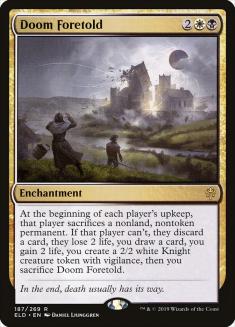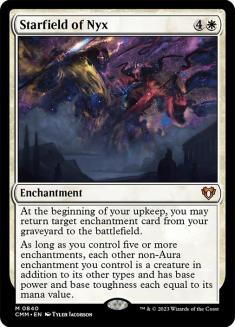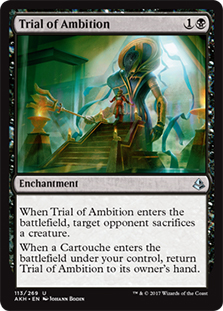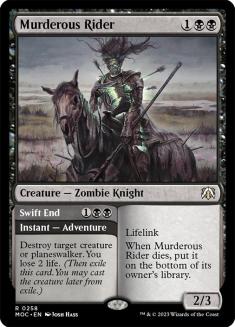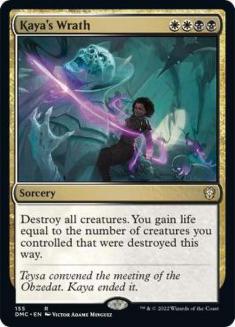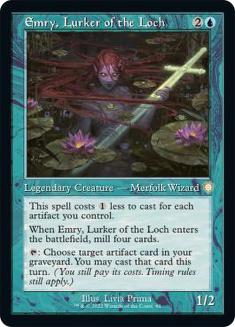I’ve spent the last several days building and testing various Doom Foretold decks, and I’ve been very impressed with the results. It started with a desire to find a good Demonic Pact deck, where I noticed that Doom Foretold was a good way to sacrifice Demonic Pact, and I quickly noticed that Demonic Pact was a higher-variance card that required worse deckbuilding sacrifices and was much riskier against decks that could potentially disrupt me, and Doom Foretold played far better, especially due to having a more immediate impact, since it gets the first trigger in my opponent’s upkeep rather than mine. I quickly discarded Demonic Pact and focused on building around Doom Foretold to remarkably good results.
As we saw in Standard when players first explored the Doom Foretold / Dance of the Manse deck, it’s fairly easy to abuse Doom Foretold’s symmetry by playing cards that are essentially spells that leave a relatively blank permanent on the battlefield, and Doom Foretold has a deceptively powerful effect, often tearing through hard-to-answer permanents before generating considerable value, and, as it happens, very few decks are prepared to interact with Doom Foretold, especially in Game 1.
The most powerful synergy I found was Doom Foretold with Starfield of Nyx. I believe there was only one time when my opponent didn’t concede a game as soon as I targeted my Doom Foretold with Starfield of Nyx, and they conceded the next turn. It’s virtually impossible to get out of that lock, since they lose any card they keep in their hand or put on the battlefield, and you’re gaining life so they can’t burn you out.
I’ve tried several different approaches and haven’t found one that feels quite right yet, but I’ve learned a lot and I’m doing well even with the “untuned” lists.
I started out by using cards like Terrarion, Trial of Ambition, and Oath of Kaya to support Doom Foretold. When playing this kind of strategy, I found that the more my deck played like a control deck, the better it functioned. I just wanted to answer my opponent’s cards and stay alive, and eventually my four copies of Doom Foretold and two copies of Starfield of Nyx would win the game.
I’m not sure how good Terrarion is. It’s relatively cheap to cycle, but it’s not an enchantment to work with Starfield of Nyx and if you cycle it it doesn’t work with Doom Foretold, so you’re incentivized to play down a card until you’ve essentially entered your end-game state.
I tried Cast Out due to its synergies with Starfield of Nyx. I could cycle it early to ensure that I’d have an enchantment to return, but wasting a mana is as expensive as always, and I don’t think it’s worth it.
Trial of Ambition is actually pretty great. You get a permanent at a very low cost, and sometimes it’s an actively great removal spell, since there are decks based around indestructible or hexproof creatures. Oath of Liliana has the advantage of being legendary, which means that if you have two of them you can loop them indefinitely with Starfield of Nyx, which is a great backup plan if you don’t have Doom Foretold, but the extra cost over Trial is too prohibitive.
I’ve been really impressed with both Murderous Rider and Kaya’s Wrath. This isn’t surprising, since Murderous Rider has been a highly played card in the format and it shouldn’t be new that four-mana sweepers are strong in control decks, but both cards have felt important in the deck. Murderous Rider is also kind of like a spell that leaves a permanent behind; I mean, it literally is, but the permanent is fairly expensive.
After trying some Orzhov Control builds (don’t worry, I’ll get to the decklists later), I moved on to Abzan. I really like the ability of Cauldron Familiar to allow you to essentially sacrifice tokens to Doom Foretold, and I thought Trail of Crumbs could be a good engine here, so I spliced the package of Gilded Goose / Cauldron Familiar / Trail of Crumbs / Golden Egg onto my Oath of Kaya / Doom Foretold / Starfield of Nyx shell with some mix of Thoughtseize, Murderous Rider, and Kaya’s Wrath. I also experimented with Commune with the Gods, but it was horrible.
I found that there’s an extremely high cost to playing even a moderate number of misses in a deck with Trail of Crumbs, since it’s pretty devastating to ever miss on finding a card, and that my deck was so reliant on synergies that cards like Thoughtseize made it a lot more likely that my draw wouldn’t amount to anything. Sideboarding was difficult; I’d want to sideboard out Gilded Goose if my opponent had removal that I thought would stay in their deck, like Bonecrusher Giant, or I’d want to sideboard out Trail of Crumbs or Golden Egg if my opponent was too fast, but that would make all my other Food cards worse. Sometimes the shell would do extremely powerful things, but often it spent too much time spinning its wheels.
So next, I decided to exacerbate this problem by switching to Esper to try a build with Emry, Lurker of the Loch.
Why? Uh, I have a problem, okay?
I’d been pretty happy with Golden Egg, all things considered, and I thought that if I played Emry, my Cat/Oven synergies might come together more often — never mind that they’d be a lot less powerful without Trail of Crumbs, but Witch’s Oven, Terrarion, and Golden Egg got me pretty close to enough artifacts for Emry, and the missing piece was a great fit: Hangarback Walker. Hangarback Walker with Emry or Witch’s Oven would let me repeatedly cash it in for Thopters.
As it turns out, Hangarback Walker costs a lot of mana to cast, so sacrificing it and recasting it every turn is generally quite a bit worse than just using its ability and leaving it on the battlefield, which really minimized the value you’re getting out of Emry, which is fine, because you can just use Emry to return Terrarion or Golden Egg, which is pretty sweet, unless all you’re drawing is more Cats, Ovens, Eggs, redundant copies of Emry, etc. Occasionally you’d get lucky and eventually spike a Doom Foretold, but by then your opponent had a lot of creatures on the battlefield.
This reinforced my belief that I want to build a control deck first and foremost, but I learned a lot of lessons on the way. One of the more interesting lessons was about mana in Pioneer.
The lands we have to work with are weird. Like, really weird. How is it so much easier to play enemy colors than allied colors? Seriously, when I was building these decks, Godless Shrine was like the third- or fourth-best multicolor land for an Orzhov deck and Watery Grave was basically the only playable one for a Dimir deck. It’s going to take years of concerted effort or a Pioneer Masters set that’s literally just lands to fix this. Enemy colors have painlands, creature-lands, and fastlands, all of which are better than the best cycle allied colors have exclusive access to, and wedges get trilands while shards don’t.
These decks aren’t good. You shouldn’t play them. If you want to play this strategy, we’ll get to better ways to do that. But I want to share what I had to discuss the choices that went into the lands:
Creatures (10)
Lands (23)
Spells (27)

Sandsteppe Citadel made my mana a lot better. It’s a tough pill to swallow, but if it’s not critical that you cast a one-drop on Turn 1, there’s a very good chance you should be playing a triland if one is available for your deck. I think that’s actually the best land in this deck, but it does so much to make my mana good that the next-best land is Caves of Koilos.
I maxed out on fastlands because they’re great, but I think that was a mistake. Llanowar Wastes is probably better than Blooming Marsh because this deck plays long games and Trail of Crumbs means that it wants to use every available mana, and this version had too many lands that enter tapped late, when you’re using colorless mana for almost everything anyway. Eight is a lot of painlands, so maybe it should have been a mix, and I want Caves of Koilos before Llanowar Wastes because the activated ability of Gilded Goose means that I’m more likely to need green mana repeatedly than white mana, but I need to be careful about making too much of my black mana painful — this is why I played an Overgrown Tomb over a Llanowar Wastes.
Basically, there are a lot of competing values to consider. You need to balance mandatory tapped lands early, mandatory tapped lands late, and amount of pain. In an aggro deck that play short games, Mana Confluence can be the best triland, but it would be horrible in this deck. The more tapped lands you have in your deck, the more you want painlands over shocklands because you’re a lot more likely to have to Shock if you have other tapped lands. At the same time, if you have few uses for colorless mana, you’ll likely end up taking a lot more damage from painlands. Sometimes you also have to balance the number of shocklands you’re playing to get land types for checklands and Castles.
All of this is to say that building manabases in this format is hard. There aren’t simple heuristics or rankings about which lands are better than which other lands that apply universally; there are tradeoffs that need to be balanced and the weight assigned changes depending on your deck.
Creatures (10)
Lands (19)
Spells (31)

Here, the mana would be awful if it weren’t for the fact that I have enough artifacts to play Spire of Industry, a lot of colorless spells, and artifacts that can fix my mana in a pinch.
Balancing shocklands, Temples, and creature-lands has also been really interesting. Some decks care a lot about early mana, some care a lot about life, some care a lot about scrying, and some care a lot about mana sinks. In this deck, if you can’t keep an Emry on the battlefield you’re a lot less likely to have something to spend your mana on than the Trail of Crumbs deck, so Shambling Vents is a much higher priority, for example.
My takeaway from the “color study” aspect of exploring this archetype is that adding a second color to a deck, especially an enemy color, is extremely cheap. It’s definitely not free, but you can also pick up a lot of utility in your lands from Temples and creature-lands by adding a color if you can afford lands that enter the battlefield tapped. Adding a third color is relatively expensive. It will cost life, mana, and utility lands in considerable quantities in most games.
As such, I’m currently most interested in exploring straight Orzhov Doom Foretold again for the moment. I’ve always been a firm believer in not playing more colors than you have to.
I’ve only explored controlling builds, but that might be an error. Dread Wanderer is a particularly fantastic enabler for Doom Foretold and black has plenty of equivalent enablers.
In the controlling space I think I like something along these lines:
Creatures (3)
Lands (21)
Spells (36)

I think it’s better to play Terrarion and Sign in Blood than Golden Egg, but I’m not sure how much I’ll mind the life loss from Sign in Blood. I’m optimistic about it, but it might be a lot with Thoughtseize and Underworld Connections, even if I have Shambling Vents, Oath of Kaya, and Doom Foretold to offset it.
It’s worth noting that Leyline of the Void is an essential sideboard card for these decks and not playing Kaya, Orzhov Usurper or some other graveyard hate card in my maindeck might be irresponsible, since the core strategy is so weak against recursive threats.
A good aggressive take might look something like this:
Creatures (23)
- 4 Bloodsoaked Champion
- 4 Scrapheap Scrounger
- 4 Dread Wanderer
- 3 Midnight Reaper
- 4 Knight of the Ebon Legion
- 4 Murderous Rider
Planeswalkers (3)
Lands (22)
Spells (12)

Note that I don’t believe the Stafield of Nyx lock is required to justify Doom Foretold. The card is very powerful by itself. I’m not sure if I’ve done enough to explain that, but if you ever watch it chew through every planeswalker in an Azorius Control deck, it should become perfectly clear.
This is essentially a small-ball aggro deck with discard and removal to keep the game small, which is ideal for Doom Foretold, and the recursive creatures allow you to almost completely ignore the consequences as Doom Foretold chews through opposing permanents. The sideboard is mostly one-for-ones to maximize your ability to efficiently trade resources to guarantee this kind of game, along with the graveyard hate required to make sure the opponent can’t play your game.
Pioneer is likely filled with unexplored gems like this, but Doom Foretold has really impressed me. It’s flexible enough to fit in a lot of strategies, but requires focused enough building around that opponents are rarely prepared for it. I’m working on figuring out the perfect shell, but it feels like one of the best Pioneer decks likely uses Doom Foretold.

